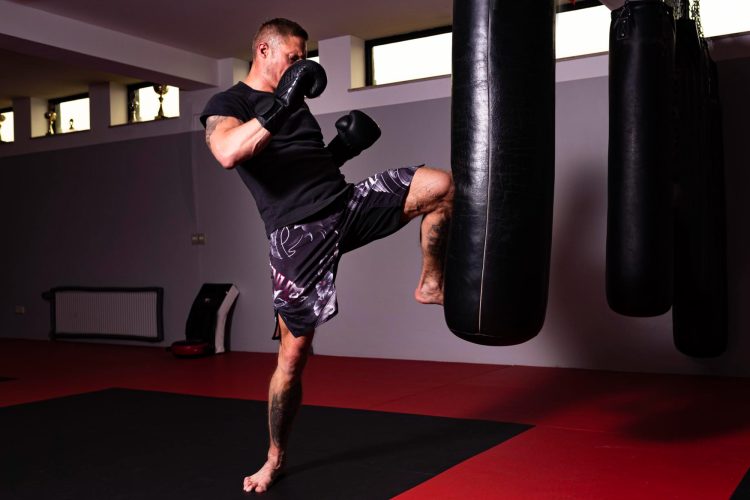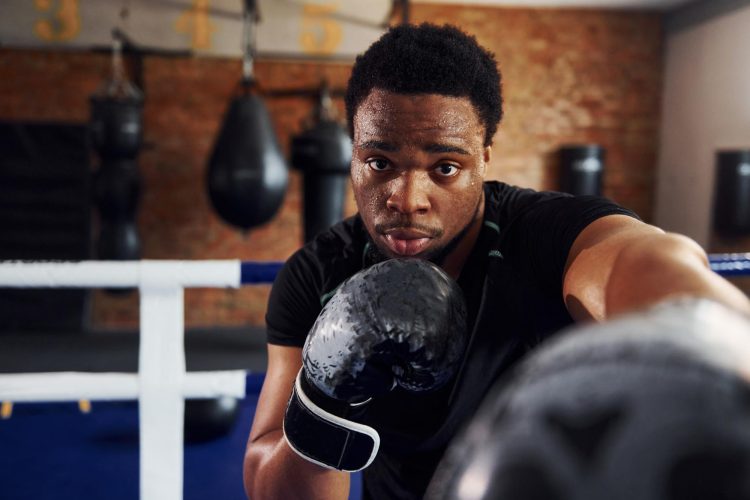If you are searching for a new fitness routine but also want to challenge yourself with a combat-based training program, look no further than kickboxing.
Kickboxing is a form of martial arts that incorporates various punches, kicks, and dodges to craft the ultimate combat system. It is also incredibly beneficial for health and fitness.
It has exploded as a way for fitness enthusiasts to get an effective and engaging workout while practicing self-defense.
Keep reading to learn the top seven benefits I have realized kickboxing has to offer as I have incorporated it into my own and my athletes’ training as a Physical Therapist and Strength coach for over 10 years!
Cardiovascular Conditioning
Kickboxing can have a tremendous impact on your cardiovascular performance and health. During a typical kickboxing session, your heart rate will keep high because of the continuous movement.
Level Up Your Fitness: Join our 💪 strong community in Fitness Volt Newsletter. Get daily inspiration, expert-backed workouts, nutrition tips, the latest in strength sports, and the support you need to reach your goals. Subscribe for free!
Through a usual 30-60 minute class, you will be punching, kicking, and dodging continuously for the whole time or with higher intensity intervals. Either of these methods will keep your heart rate at a trainable level.
With consistent workouts, your heart will become more proficient at pumping oxygenated blood throughout the body to the working muscles, and your muscles will become more adept at utilizing oxygen. (1)
Kickboxing will utilize various energy systems in a typical class or match if you are someone who competes but will primarily use the aerobic energy system (2). The aerobic energy system will dominate during longer sessions with lower intensity. Still, the rest breaks are shorter or less frequent.
During periods of intense combinations, kickboxing’s rapid dodging maneuvers, or strength activities, the anaerobic energy system will primarily be used. (2)
Combining these two energy systems makes kickboxing a great way to develop multiple aspects of your fitness so that you are ready for anything.
Full Body Workout
Since kickboxing includes a variety of movement patterns to accomplish effective punches, kicks and dodges, and various strengthening activities like squats, push-ups, and core, the entire body is trained during a workout. The full-body nature makes kickboxing a go-to choice if your goals include total body conditioning and building an athletic physique.
In kickboxing, the upper body will get most of its work from the punching combinations against a punching bag or speed bag. But, in a kickboxing class, you can expect to get the same work for the upper body but also through strengthening exercises like push-ups, pull-ups, battle ropes, and weighted shadow boxing.
The lower body will get trained through kick combinations such as straight, roundhouse, and lateral kicks. However, the lower body will also be trained by running, burpees, squats, lunges, and plyometrics.
Regardless of the exercises, the core will be trained extensively in kickboxing. Punching and kicking are called “core to extremity” movements. Core-to-extremity movements initiate at the core and finish with the limbs.
As you begin to throw a combination, you will notice that first, the core will brace to create stability so that the limbs have a stable base to move upon. Without this initial bracing, it would be like trying to launch a cannonball off a canoe. You could do it, but it would not be as effective or powerful as if you shot it on stable ground.
Calorie Burning and Weight Loss
Given that you are moving for a long time in a kickboxing class and transitioning from sustained, lower-intensity movement to high-intensity combinations, your typical calorie burn in a kickboxing class will be substantial.
A 155-pound individual can burn around 372 calories in a typical kickboxing class in 30 minutes. If you extrapolate that to an entire 60-minute class, that is up to 744 calories burned in one workout.
Thus, if you can practice great lifestyle behaviors, including proper nutrition, sleep, stress management, etc., joining a kickboxing class can rapidly improve your body fat percentage and total weight.
When strength training is involved in your kickboxing workouts, it can also help build strength and muscle mass. This can increase your metabolic rate even further since muscle mass is more metabolically expensive to maintain. So, you will also be burning more calories outside of your workouts.
Improved Flexibility and Coordination
To achieve effective punches, especially kickboxing kicks, adequate joint mobility and muscle flexibility are required. Launching many kicks that land on a punching bag or dummy as high as their head is not uncommon for a kickboxer.
Level Up Your Fitness: Join our 💪 strong community in Fitness Volt Newsletter. Get daily inspiration, expert-backed workouts, nutrition tips, the latest in strength sports, and the support you need to reach your goals. Subscribe for free!
A tremendous amount of mobility is needed at the hips and spine to achieve this position. You will also need great muscle flexibility in the hamstrings, adductors, and glutes. At the same time, it requires high levels of coordination at the level of the limbs and the individual muscles.
As far as the limbs go, during a kickboxing kick, you must be able to see where you want to land your attack and then coordinate your movement to shift your body weight to the stance leg and propel the other leg toward your target.
The brain’s motor cortex and cerebellum play key roles in motor learning and work together to perform this maneuver. Through practice and feedback over time, the brain continuously adapts the kicking movement for improved performance. (3)
This process is why, over time, you will see your combinations become more efficient and powerful as your brain learns the skill of punching and kicking while the muscles become stronger and more capable.
Stress Relief and Mental Health
The impact of kickboxing on stress management and mental health cannot be understated. With any exercise, there is a release of endorphins, which are also known as the “feel good” hormones.
These endorphins are neurotransmitters that act as natural painkillers and mood enhancers. They provide a sense of euphoria and overall well-being after they are released post-exercise. (4)
The rigors of kickboxing can also promote the release of other endorphins, such as serotonin, dopamine, and norepinephrine. Serotonin can assist in stabilizing your mood throughout the day, and dopamine and norepinephrine can combat feelings of depression or anxiety.
Research also supports that regular exercise can reduce cortisol levels, the stress hormone. Lower cortisol levels in the body can contribute to a calmer mental state and reduce the adverse effects of stress on the body. (4)
Regarding health and fitness, this could negatively impact sleep, body fat percentage, and your ability to recover from exercise.
Self-Defense Skills
Since kickboxing is a form of martial arts, you will undoubtedly develop a better ability to defend yourself. Even if your goal is health and fitness and not combat, you will better understand how to throw punches, land kicks, dodge attacks effectively, and ultimately put these things together if you ever need to defend yourself.
In a kickboxing class, you may work various combinations on a heavy bag, a realistic punching dummy, or even sparring with a fellow class member. These will develop your attack instinct and help defend against unwanted advances.
Being able to defend yourself is one of the biggest confidence boosters you can possess, and building your confidence as high as possible can also have various other benefits. These include better mental health, self-efficacy, and performance at work.
Social Interaction and Community
The final piece on how kickboxing can benefit you is the social aspect of taking classes and training with others. Doing so fosters a sense of community among the gym members because you are battling through hardship together, and with each successful workout you complete together, that bond is strengthened even more.
This social benefit may extend to member gatherings, gym events, or relationship-building outside the gym. It is not uncommon for fitness community members to meet each other in the gym and, over time, develop such strong relationships outside the gym that they eventually become significant others.
In my time as a fitness coach, this has happened several times when two members joined, met in a class, and their relationship developed into marriage.
The camaraderie built inside a social gym can help you create a social network that can provide mental health benefits and support to reduce feelings of isolation.
FAQ’s
Is kickboxing for all ages?
Yes! With the proper coaching and scaling of complexity, intensity, and volume, kickboxing can be excellent for youngsters and older adults. But, as with any exercise program, you must get your doctor’s clearance before starting a new exercise program, especially if you are dealing with pre-existing conditions.
What parts of the body do kickboxing tone?
Since kickboxing is a full-body workout, a typical training plan will tone the entire body. However, it is essential to remember that there is more to building muscle mass and losing body fat than simply exercising. A balanced exercise, nutrition, and recovery program is needed to improve your physique.
How many times a week should I do kickboxing?
The frequency of kickboxing will vary for each individual, depending on their skill level, training experience, and the intensity of the workouts. But, as a general rule of thumb, the World Health Organization recommends 150-300 minutes of aerobic exercise each week, translating to roughly 3-5 weekly kickboxing sessions. (5)
Final Thoughts on the Benefits of Kickboxing
As you can see, engaging in regular kickboxing workouts has many benefits, including improved cardiovascular health, mental health, and increased confidence from knowing you are prepared to defend yourself if needed.
If you are searching for a new fitness routine, look no further than group kickboxing classes. They offer an excellent way to build your fitness in a community of like-minded people. Don’t forget to have fun while you are at it!
References:
- Hellsten, Y., & Nyberg, M. (2015). Cardiovascular Adaptations to Exercise Training. Comprehensive Physiology, 6(1), 1–32. https://doi.org/10.1002/cphy.c140080
- Baker, J. S., McCormick, M. C., & Robergs, R. A. (2010). Interaction among Skeletal Muscle Metabolic Energy Systems during Intense Exercise. Journal of nutrition and metabolism, 2010, 905612. https://doi.org/10.1155/2010/905612
- Dayan, E., & Cohen, L. G. (2011). Neuroplasticity subserving motor skill learning. Neuron, 72(3), 443–454. https://doi.org/10.1016/j.neuron.2011.10.008
- Mikkelsen, K., Stojanovska, L., Polenakovic, M., Bosevski, M., & Apostolopoulos, V. (2017). Exercise and mental health. Maturitas, 106, 48–56. https://doi.org/10.1016/j.maturitas.2017.09.003
- World Health Organization. (2023, October 5). Physical activity. [Fact sheet]. Retrieved from https://www.who.int/news-room/fact-sheets/detail/physical-activity











